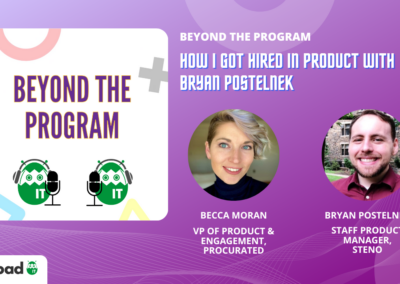The following insight was written by Josh Tong, Principal Product Manager at CognitOps.
What have you done as a product manager to create buy-in around your product vision?
I’ve seen this play out different ways. Some product leaders succeeded; others never got buy-in.
In this article, we’ll begin by starting with the implicit issue, why buy-in is so hard. Then we’ll move on to how you can get buy-in for your product vision.
Why is buy-in so hard?
Buy-in is hard because you need people to adopt not only on your Product Vision, but also your view of the market, company, and product.
Product vision is a conclusion about the best direction for your product based on your assessment of the market, company, and product.

Sometimes people do balk at your vision; however, they probably don’t buy your assessment of the market, company or product.
I’ve seen PM’s get extremely frustrated, because they miss this point. Its like stubbing your toe on an invisible curb. The PM is focused on the Product Vision, yet oblivious to the fact that the issue is not the Product Vision at all. Its the prerequisite assumptions that the Product Vision is built on.
That may feel like splitting hairs. Let me circle back to the main point. When you’re getting push back on your Product Vision, focus you energy on discovering where your assessments of the market, company, and product disagree. That’s the key.
How can you get buy-in on your product vision?
There is no one approach to this; however, here are some tactics I’ve seen work well. They’ll probably improve your odds of success.
1. Start with Small Conversations
We just talked about how Product Visions are built on assessments of the market, company, and product. We also know our team will have their own assessments. So your first job is to understand how your team views their world.
Don’t boot up Powerpoint and start building the Product Vision deck. You want to uncover the land mines informally, in one-on-one settings, instead of in the official Product Vision meeting. Start with small conversations with your team.
Understand how they view the world. Share some observations about the market; see where they push back. Update them on the state of the product; were they surprised or concerned? Casually pre-flight elements of the product vision; find disconnects and surface objections.
My favorite part of this approach is that it allows you to gain buy-in incrementally one conversation at the time. You’re not trying to get people bought into the grand vision in one step. You’re leading them through the thought process a a few steps at a time. People don’t often change their minds in one sitting; however, your odds go way up when you try to gain alignment over multiple conversations.
Side note: We have blind spots too. Informal conversations at the hotel bar on a business trip or chatting on your way out to the parking garage are equally valuable for PMs. Are our original assessments correct? Is our vision clear? What parts of the vision are the hardest to swallow? A few conversations will get you along way down the road towards answering these questions.
2. Beware of Assessment Sticking Points
Okay, I now want to get really concrete about market, company, and product assessments. There are many great questions you can use to assess these areas, but I want to call your attention to several that tend to sticking points for product vision buy-in:
Company Assessments
- What type of company are we (or trying to become)?
- What business objectives are we trying to achieve?
- What time horizon matters the most right now?
Market Assessments
- What do our customers care most about? –
- What are the biggest threats to our business?
Product Assessments
- What is the biggest risk/opportunity for the product?
- How quickly/effectively can our team build ‘X’?
- What other priorities/commitments exist?
3. Deliver the Official Pitch
Each successful Product Vision rollout I’ve observed also included a well-articulated, logical case for the product vision. In one case it was written out narrative style in a 4-page Google Doc. In another case it was a plain, unformatted PowerPoint deck that we presented verbally to the team. Regardless of format there needs to be a cohesive, logical narrative that makes the official case for your Product Vision.
By the end of the meeting, you want (need) the entire team sitting around the table nodding their head and, at least tentatively, agreeing to support this vision. If you didn’t pre-sell your vision (and the assessments its built on) then the meeting probably will go poorly. Most PMs need to pre-sell it with several weeks (or months at times) of incremental conversations. But assuming you succeed…congratulations! You now have your team on-board.
4. Keep Drawing Connections
In a few weeks, your Product Vision presentation will be a fuzzy memory in most people’s minds. People forget. They’ll drift back to their pre-bought-in mindset. Its drives us PMs insane, but its the way it works. Your new job is to reinforce the Product Vision.
My favorite example of this occurred in the middle of an sprint demo. We were all crammed in the small 5th-story cafeteria of our downtown office, with product, development, and a mishmash of people from other departments. The product team had just introduced a new feature. One of the executives immediately thought it might be a quick win. Seeing this as a flawed assessment of the product’s ability to deliver results in such a short timeframe, our Chief Product Officer simply said, “Think of this like baseball. Its often a long, boring game. We’ll get results, but it won’t be overnight.” He already had official buy-in on the product vision/strategy, but he used this simple opportunity to continue reinforcing the assessments that were underlying that vision.
Closing Thoughts
In fact, baseball is probably a great metaphor for getting buy-in on a Product Vision. Its often a long, boring game. But incremental wins in small conversations and situations tends to add up to a ‘W’ on the scoreboard at the end of the day. Good luck on your efforts and feel free to add a comment if you have any followup questions.





